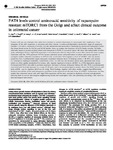Estrogen receptor-α directly regulates the hypoxia-inducible factor 1 pathway associated with antiestrogen response in breast cancer.
| dc.contributor.author | Yang, J | en |
| dc.contributor.author | AlTahan, A | en |
| dc.contributor.author | Jones, DT | en |
| dc.contributor.author | Buffa, FM | en |
| dc.contributor.author | Bridges, E | en |
| dc.contributor.author | Interiano, RB | en |
| dc.contributor.author | Qu, C | en |
| dc.contributor.author | Vogt, N | en |
| dc.contributor.author | Li, J-L | en |
| dc.contributor.author | Baban, D | en |
| dc.contributor.author | Ragoussis, J | en |
| dc.contributor.author | Nicholson, R | en |
| dc.contributor.author | Davidoff, AM | en |
| dc.contributor.author | Harris, AL | en |
| dc.date.accessioned | 2016-08-09T14:41:54Z | |
| dc.date.available | 2016-08-09T14:41:54Z | |
| dc.date.issued | 2015-12-08 | en |
| dc.identifier.uri | http://hdl.handle.net/10026.1/5244 | |
| dc.description.abstract |
A majority of breast cancers are driven by estrogen via estrogen receptor-α (ERα). Our previous studies indicate that hypoxia-inducible factor 1α (HIF-1α) cooperates with ERα in breast cancer cells. However, whether ERα is implicated in the direct regulation of HIF-1α and the role of HIF-1α in endocrine therapy response are unknown. In this study we found that a subpopulation of HIF-1α targets, many of them bearing both hypoxia response elements and estrogen response elements, are regulated by ERα in normoxia and hypoxia. Interestingly, the HIF-1α gene itself also bears an estrogen response element, and its expression is directly regulated by ERα. Clinical data revealed that expression of the HIF-1α gene or a hypoxia metagene signature is associated with a poor outcome to endocrine treatment in ERα(+) breast cancer. HIF-1α was able to confer endocrine therapy resistance to ERα(+) breast cancer cells. Our findings define, for the first time to our knowledge, a direct regulatory pathway between ERα and HIF-1α, which might modulate hormone response in treatment. | en |
| dc.format.extent | 15172 - 15177 | en |
| dc.language | eng | en |
| dc.language.iso | eng | en |
| dc.subject | ERα | en |
| dc.subject | HIF-1α | en |
| dc.subject | tamoxifen | en |
| dc.subject | Breast Neoplasms | en |
| dc.subject | Drug Resistance, Neoplasm | en |
| dc.subject | Estrogen Receptor Modulators | en |
| dc.subject | Estrogen Receptor alpha | en |
| dc.subject | Female | en |
| dc.subject | Humans | en |
| dc.subject | Hypoxia-Inducible Factor 1, alpha Subunit | en |
| dc.subject | Signal Transduction | en |
| dc.subject | Tamoxifen | en |
| dc.subject | Transcription, Genetic | en |
| dc.title | Estrogen receptor-α directly regulates the hypoxia-inducible factor 1 pathway associated with antiestrogen response in breast cancer. | en |
| dc.type | Journal Article | |
| plymouth.author-url | https://www.ncbi.nlm.nih.gov/pubmed/26598706 | en |
| plymouth.issue | 49 | en |
| plymouth.volume | 112 | en |
| plymouth.publication-status | Published | en |
| plymouth.journal | Proc Natl Acad Sci U S A | en |
| dc.identifier.doi | 10.1073/pnas.1422015112 | en |
| plymouth.organisational-group | /Plymouth | |
| plymouth.organisational-group | /Plymouth/REF 2021 Researchers by UoA | |
| plymouth.organisational-group | /Plymouth/REF 2021 Researchers by UoA/UoA01 Clinical Medicine | |
| plymouth.organisational-group | /Plymouth/REF 2021 Researchers by UoA/UoA01 Clinical Medicine/UoA01 Clinical Medicine | |
| dc.publisher.place | United States | en |
| dc.identifier.eissn | 1091-6490 | en |
| dc.rights.embargoperiod | Not known | en |
| rioxxterms.versionofrecord | 10.1073/pnas.1422015112 | en |
| rioxxterms.licenseref.uri | http://www.rioxx.net/licenses/all-rights-reserved | en |
| rioxxterms.type | Journal Article/Review | en |


